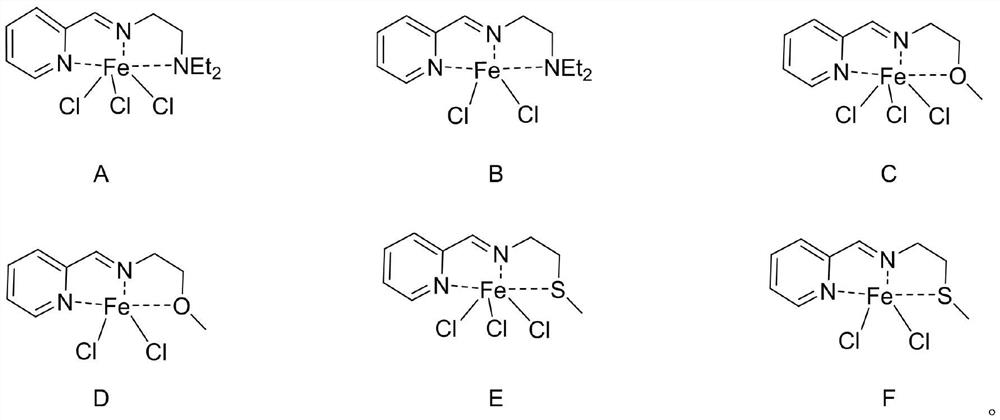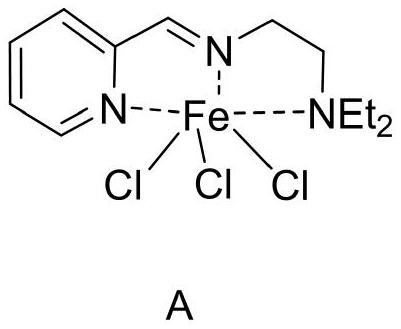A kind of tridentate pyridinium iron series catalyst and its preparation method and application
A technology of tridentate pyridineimide iron series and tridentate pyridineimide iron, which is applied in the field of conjugated diene catalytic polymerization, and can solve problems such as unreported
- Summary
- Abstract
- Description
- Claims
- Application Information
AI Technical Summary
Problems solved by technology
Method used
Image
Examples
Embodiment 1
[0031] This example prepares the tridentate pyridinium iron complex shown in formula (A):
[0032] The 25mL Schlenk reaction tube was pumped and baked three times, and 15mL redistilled dichloromethane, equimolar ratio of anhydrous FeCl 3 and tridentate pyridine imine ligand substituted by diethylaminoethyl (1.5 mmol) (structural formula LA), and stirred at room temperature for 24 h. After the reaction, the dichloromethane was vacuum-dried, washed twice with 10 mL redistilled n-hexane (the filtrate was colorless and clear), and vacuum-dried to constant weight to obtain an off-white solid, structural formula:
[0033]
[0034] Mass Spectrometry: C 12 h 19 Cl 3 FeN 3 :[M-Cl] + : Theoretical value: 331.0300; measured value: 331.0305.
[0035] Elemental Analysis: C 12 h 19 Cl 3 FeN 3 : Theoretical value: C, 39.22%; H, 5.21%; N, 11.43%; Measured value: C, 39.18%; H, 5.25%; N, 11.38%.
Embodiment 2
[0037] The preparation process of the tridentate pyridinium iron complex shown in formula (B) prepared in this example is as follows:
[0038] The 25mL Schlenk reaction tube was pumped and baked three times, and 15mL redistilled dichloromethane, equimolar ratio of anhydrous FeCl 2 and tridentate pyridine imine ligand substituted by diethylaminoethyl (1.5 mmol) (structural formula LA), and stirred at room temperature for 24 h. After the reaction, the dichloromethane was vacuum-dried, washed twice with 10 mL redistilled n-hexane (the filtrate was colorless and clear), and vacuum-dried to constant weight to obtain a light blue solid with the structural formula:
[0039]
[0040] Mass Spectrometry: C 12 h 19 Cl 2 FeN 3 [M-Cl] + : Theoretical value: 296.0611; measured value: 296.0605.
[0041] Elemental Analysis: C 12 h 19 Cl 2 FeN 3 : Theoretical value: C, 43.41%; H, 5.77%; N, 12.66%; Measured value: C, 43.45%; H, 5.75%; N, 12.62%.
Embodiment 3
[0043] The preparation process of the tridentate pyridineimine iron complex shown in formula (C) prepared in this example is as follows:
[0044] The 10mL Schlenk reaction tube was pumped and baked three times, and 15mL redistilled dichloromethane, anhydrous FeCl 3 and methoxyethyl-substituted tridentate pyridine imine ligand (1.5 mmol) (structural formula LB), and stirred at room temperature for 48 h. After the reaction, the dichloromethane was vacuum-dried, washed twice with 10 mL redistilled n-hexane (the filtrate was colorless and clear), and vacuum-dried to constant weight to obtain a light red solid, structural formula:
[0045]
[0046] Mass Spectrometry: C 9 h 12 Cl 3 FeN 2 O[M-Cl] + : Theoretical value: 289.9671; measured value: 289.9668.
[0047] Elemental Analysis: C 9 h 12 Cl 3 FeN 2 O: Theoretical value: C, 33.12%; H, 3.71%; N, 8.58%; measured value: C, 33.15%; H, 3.65%; N, 8.61%.
PUM
| Property | Measurement | Unit |
|---|---|---|
| molecular weight distribution | aaaaa | aaaaa |
| molecular weight distribution | aaaaa | aaaaa |
| molecular weight distribution | aaaaa | aaaaa |
Abstract
Description
Claims
Application Information
 Login to View More
Login to View More - R&D
- Intellectual Property
- Life Sciences
- Materials
- Tech Scout
- Unparalleled Data Quality
- Higher Quality Content
- 60% Fewer Hallucinations
Browse by: Latest US Patents, China's latest patents, Technical Efficacy Thesaurus, Application Domain, Technology Topic, Popular Technical Reports.
© 2025 PatSnap. All rights reserved.Legal|Privacy policy|Modern Slavery Act Transparency Statement|Sitemap|About US| Contact US: help@patsnap.com



